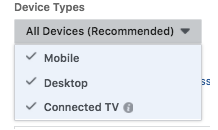Is Facebook Trying to Move Into TV Advertising?
When it comes to advertising through Facebook, there’s a variety of ways and places you can reach your audience. Most of them are the typical placements, like Facebook and Instagram feeds but recently they rolled out a new placement that is raising questions about whether or not Facebook is going to try and take over the television advertising sphere. This placement is called “Connected TV”, this blog post will walk you through what this placement is, how it works and what it means for Facebook advertisers.
Facebook has defined this describes this placement in the platform by saying, “In order to target ads to connected TV devices, Facebook may use data such as IP address or Bluetooth to link a connected TV to a household and/or to determine which individual is watching the connected TV. Ads that are not relevant for household delivery may not be shown on connected TVs. Reporting will be on an individual basis even if multiple members of a household were reached.”

What is the “Connected TV” Placement?
Connected TV essentially means that the user has a smart television. A smart television is defined as a TV as a digital television that is internet-connected and has advanced functions. This includes televisions that have apps for surfing the internet and streaming sites like Hulu. This opens up an entirely new area for advertisers to test.
Related: Facebook Advertising & News Feed Algorithm History
How Does it Work?
By choosing this placement you will be advertising through Facebook’s audience network. Facebook doesn’t provide a lot of clarity into what television networks that it includes but what Facebook does share is that your ad will appear in-stream. This does raise some questions about where your ad may show up. Although this placement could be huge as millennials continue to shift away from traditional cable Facebook isn’t providing enough transparency to ease the fear that your advertisement might end up on an unsavory network. This takes us back to when we discovered that the audience network allowed placements on Breitbart and there was little we could do as advertisers to opt out of specific sites (Facebook has since allowed more capabilities in terms of opting out of specific placements).
Facebook additionally uses a scare tactic to encourage users to not opt-out of placements, saying that this will hurt the ads delivery and “result in fewer people viewing the ad.”
What Does it Mean for Advertisers?
As the newer generations shift away from traditional cable packages this may be an opportunity for brands to ensure they get in front of the right people. With that being said, there is not enough data or background on this new placement to provide a clear decision on whether or not this placement is worth testing.
When advertising on Facebook, we typically boast that we can gather clear metrics on whether or not an ad is performing thus allowing us to make a decision that is backed by data. With this new placement there are a few things that cause concern around our tried and true claim of data backed decision making. As mentioned earlier, when describing this placement Facebook stated, “reporting will be on an individual basis even if multiple members of a household were reached.” Although, Facebook positions this as a benefit because you technically could reach more users without an increase in cost it doesn’t take into account the fact that when a device is shared oftentimes the actual user you are trying to reach may not even be present.
For example, if the ad is delivered to a users television but this television is in a shared space, it’s possible that a family member or roommate could be viewing the advertisement while the person you are trying to target is not present. This seems like a step backwards in some ways as we may need to rely on fluffy brand awareness metrics and we may not be able to optimize based on accurate data.
Related: Video Advertising on Facebook Best Practices & Tips
If your ultimate campaign goal is to drive revenue, you may run into issues with this ad type. Because it is positioned more around brand awareness objectives, it is far less likely you’ll be able to directly drive users to your site where they can convert. This is especially due to the fact that the ad is viewed on their television rather than on a computer or mobile device where they can easily click on advertisements to learn more.
One huge advantage of advertising on Facebook is that we can target users so we accurately serve them products or services that truly fit their interests, if we can’t be as tailored with who we serve ads to it may lead to a poor user experience.
Additionally, this ad placement is only available for campaigns with the objectives of video views, brand awareness, and engagement objectives. So if your main focus is driving direct response, this may not be a viable ad type for your business or client.
There is one massive upside to this ad type. Users are far more likely to watch your advertisement in its entirety on this platform, meaning you have a unique opportunity to capture their full attention and create retargeting audiences based on the amount of your video viewed.
Wrapping Up
Though there are some questions about the value and effectiveness of this ad type, that absolutely does not mean you should rule it out. It is essential as an advertiser to always pay attention to updates and look for ways it can benefit your brand. As this ad type expands and we learn more about its effectiveness, we might just find it’s a great supplement to an effective social advertising strategy. Though this placement is a huge step for Facebook and their advertising reach, it doesn’t mean it will be an overnight success and it may take some time to perfect it in order to drive optimal results.


















